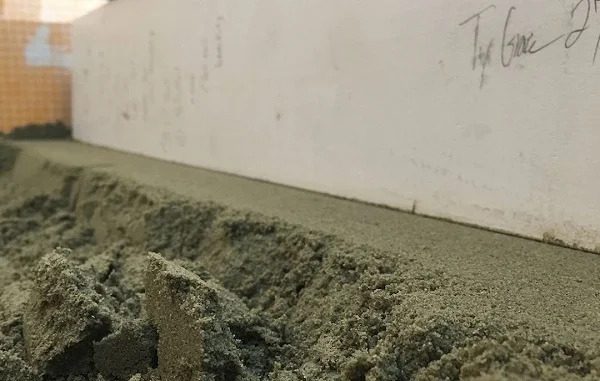Dry pack mortar also known as deck mud or floor mud is made by combining sand, cement, and water.
It is used to install bed showers, make thick bed mortar for laying tile and brick, and correct minor blemishes.
In this article you’ll learn:
- Purpose of the dry pack mortar.
- Types of dry pack mortars.
- Merits and Demerits of the dry pack mortar.
- Lots more.
So, if you’re ready to go with it, this article is for you.
Let’s get in right now.
What is a Dry Pack Mortar?
A dry pack mortar is created by mixing Portland cement, sand, and just enough water to hydrate the cement through the screen. It is sometimes referred to as deck mud or floor mud.
One part cement to four parts sand, plus just enough water to make mortar that sticks together when formed into a ball with hands, is the ratio of the combination.
In addition, neither low water nor high-water proportion should cause the ball to collapse. According to the information provided, this mixture will have a compressive strength of 21 MPa.
Purpose of Dry Pack Mortar:
- It makes small repairs when the depth is greater than the width.
- Filling the holes created when form ties are removed, including those for cone bolts, core holes, and grout-insert holes.
- Cut small slots for crack healing.
Preparation of Dry pack Mortars:
All that is needed to make dry pack mortar is cement, fine aggregate, and water.

The mixture typically consists of one part cement and 2.5 parts sand, strong strength to prevent excessive shrinkage, and low water content is preferred.
Useful sand or fine aggregate must pass through a sieve.
When adding water to a dry-pack mortar, make sure the mixture forms a ball in your hand and doesn’t crumble or slump because it contains a substantial amount of cement.
Its colour is often black and may not coincide with the colour of the concrete’s surface, however, white cement can be utilized if color homogeneity is needed.
Proportion of Dry Mix Mortar:
One part cement to four parts sand, preferably sharp, clean sand, is said to be sufficient.
On the other hand, mix ratios of one to two and a half, one to five, and even six are documented.
Depending on how wet the used sand is, different amounts of water will be required.
More water would be required in the case of low moisture sand than in the case of high moisture sand.
There are two possible dry mix mortar mix ratios: 1:3 and 1:5.
The usage for which dry mortar mix is intended determines the mix proportion.
Dry Pack Mortar for the Installation of Tiles:
Step 1: First, make a dry pack mortar using three parts fine sand and one part Portland cement. It should have enough water added to it to completely mix it.
Step 2: Apply tile adhesive to the floor and then evenly layer mortar mixture over the surface.
Step 3: Apply a skimming coat to the dry pack’s top layer. It is used to level the floor prior to the installation of tiles. Your tiles’ endurance is also ensured by dry pack mortars.
Step 4: Apply the tiles to the mortar and give it a light tap to secure it. If the floor has significant fissures, then this mortar will level it out.
Step 5: Give it 24 hours to dry. Never let it have a large load on it. This dry pack mortar dries and cures over time.
Advantages Dry pack Mortars:
- They are employed for both interior and exterior purposes.
- Sand and cement do not need to be mixed on the job site anymore.
- It is easily compaction-tamped-and-sloped.
- On big jobs, it assures a constant mix.
- It saves time and money.
- Also improvement in cracks, workability and durability.
Disadvantages Dry Pack Mortars:
- In this mortar, there are a few risks of shrinking.
- Where relatively more mortar is needed, it is not appropriate.
- This mortar will not make a strong bond with the surface.
Applications of Dry Pack Mortar:
- They are sometimes used to build uniform, substantial mortar beds.
- It is used to level surfaces made of concrete that are 51 mm thick or less.
- Also utilized for shower bases that float.
- It can be used as a detachable floating mortar bed over a fracture membrane or waterproofing membrane or it can be firmly connected.
- Use in both dry and damp regions, in-home and commercial applications.
Also read: Mortar vs Concrete | Lime Mortar | Types of Mortar
Conclusion:
A strong sand-cement mortar is frequently used to patch up small, narrower-than-deep cracks.
For filling holes in concrete walls and floors, dry pack mortar is primarily utilized.
Filling the gap between the pavers with dry cement mortar.

Related Posts
Rock Quality Designation(RQD): Building Strong Foundations
Spread Footing
Masonry Cement
Plain Cement Concrete
Concrete Efflorescence
Concrete Pile
Stepped Footing
Fineness Modulus of Coarse Aggregates
Difference between Condo and Apartment